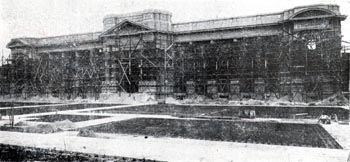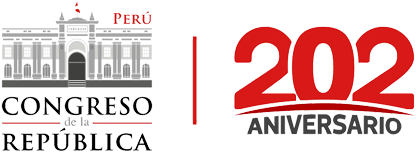“Año de la recuperación y consolidación de la economía peruana”
“Year of the Recovery and Consolidation of the Peruvian Economy”
“Jahr des Aufswungs und der Konsolidierung der peruanischen Wirtschaft”
“Année de la reprise et de la consolidation de l'économie péruvienne”
“Peru mamallaqtapaq qullqi kausarichiypaq, sinchiyachina wata”
GETTING ACQUAINTED WITH THE LEGISLATIVE PALACE
.jpg)
Currently, the Congress of the Republic of Peru sits at the Legislative Palace, located on the second block of Ayacucho Street, across from Bolívar Square, at the Historical Center of Lima. At this building, we can find the main rooms of Parliament, such as the Plenary Session Hall, Raul Porras Barrenechea Hall, the offices of the Presidency, the Vice Presidencies, the offices and rooms of the Committees, Parliamentary Groups, and the offices of the parliamentary service, such as the Secretariat General, the Parliamentary General Directorate, etc.
The Congress of the Republic also has additional facilities located at the historical center of Metropolitan Lima. These are the Inquisition and Congress Museum, located on the fifth block of Junin St.; the “Legislative Complex” on the second block of Abancay Ave., the “Reyser and Curione” building on the third block of Junin St., and the “Jose Faustino Sanchez Carrion” building on the fourth block of Azangaro Street, and the “Luis Alberto Sanchez” building on the third block of Huallaga Street.
The construction of Legislative Palace started in 1904, despite the fact that the beginning of parliamentary life in our country began in 1822. The first congressional activities were held at the then main building of San Marcos University, located on the Inquisition Square, now called Bolivar Square, in order to enforce a Supreme Decree issued on June 15, 1822, by General San Martin, ruling that also implied the temporary moving of the university to the old Saint Peter School.
The said decree read as follows:
|
DECREE OF JUNE, 15, 1822 THE SUPREME DELEGATE Has decided and decreed:
Issued on Supreme Palace of Government in Lima, on June 15, 1822. |
In 1904, during President Jose Pardo’s administration, the construction works of the current seat of Congress began at the site previously occupied by the chapel of San Marcos University and the Convent of the Charity; the Session Hall was erected on the site occupied by the university and the Raul Porras Barrenechea hall was constructed on the site occupied by the convent.
The construction initially followed the original plans prepared by the French architect, Emilio Robert. Then, starting in 1919, the building was continued by the engineer Ricardo de Jaxa Malachowski, who made some amendments to the plan.
Some authors, such as Ismael Echegaray, state that on September 24th, 1908, the Legislative Palace was inaugurated. For then, the construction of the Plenary Session Hall was already finished, and it served to hold the ceremony of the transference of presidential power from the leaving President Jose Pardo y Barreda to the incoming President Augusto B. Leguia y Salcedo.

The House of Representatives started sitting at the new site in 1912, when only the wing of the Plenary Session Hall and the Lost Steps Hall were finished. It was only in 1919 that the construction was finished. The House of Senators was definitively installed in 1938, a date on which the construction of the area for the Senate was finally concluded. The first activity held on the new site was the VII Pan American Conference.
It should be noted that during the period between 1904 and 1938, while the Legislative Palace was being constructed, the old Court of the Holy Office of the Holy Inquisition served as the session room for the Senators’ House. Between the years of 1906 and 1912, the Room of the Old Exposition Palace, now called Art Museum, served the same purpose for the House of Representatives.
--------------------------------------------------------
*Information taken from the book “The House of Representatives and the Constituent Assemblies of Peru” by Ismael Echegaray C., published by the Congress of the Republic on February 28th, 1965, Lima, Peru, p. 767.
SOURCE: MUSEUM OF THE CONGRESS AND THE INQUISITION
- History of the Legislative Palace
- Getting acquainted with the Legislative Palace





